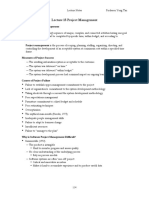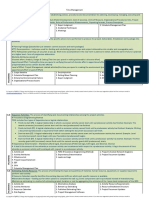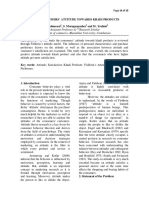LN15
LN15
Uploaded by
utcm77Copyright:
Available Formats
LN15
LN15
Uploaded by
utcm77Original Description:
Copyright
Available Formats
Share this document
Did you find this document useful?
Is this content inappropriate?
Copyright:
Available Formats
LN15
LN15
Uploaded by
utcm77Copyright:
Available Formats
I S 460
Lecture Notes
Professor Yong Tan
Lecture 15 Project Management
Project and Project Management A project is a [temporary] sequence of unique, complex, and connected activities having one goal or purpose and that must be completed by specific time, within budget, and according to specification. Project management is the process of scoping, planning, staffing, organizing, directing, and controlling the development of an acceptable system at a minimum cost within a specified time frame. Measures of Project Success
The resulting information system is acceptable to the customer. The system was delivered on time. The system was delivered within budget. The system development process had a minimal impact on ongoing business operations.
Causes of Project Failure Failure to establish upper-management commitment to the project Lack of organizations commitment to the system development methodology Taking shortcuts through or around the system development methodology Poor expectations management Premature commitment to a fixed budget and schedule Poor estimating techniques Overoptimism The mythical man-month (Brooks, 1975) Inadequate people management skills Failure to adapt to business change Insufficient resources Failure to manage to the plan
Why is Software Project Management Difficult? Summerville (1992) The product is intangible Hard to monitor progress and assess quality No clear understanding of the underlying process Rely on process models Software systems are often one-off project Critical and innovative in nature Makes it hard to accumulate experience and to produce useful data
1/4
I S 460
Lecture Notes
Professor Yong Tan
Project Management Tools & Techniques A PERT chart is a graphical network model that depicts a projects tasks and the relationships between those tasks. Program Evaluation and Review Technique A Gantt chart is a simple horizontal bar chart that depicts project tasks against a calendar. Each bar represents a named project task. The tasks are listed vertically in the left-hand column. The horizontal axis is a calendar timeline. Joint Project Planning Strategy Joint project planning (JPP) is a strategy wherein all stakeholders in a project (meaning system owners, users, analysts, designers, and builders) participate in a one-to-three day project management workshop, the result of which is consensus agreement on project scope, schedule, resources, and budget. (Of course, subsequent workshops or meetings may be required to adjust scope, budget, and schedule.) Project Management Functions Scoping Planning Estimating Scheduling Organizing Directing Controlling Closing Activity 1: Negotiate Scope Scope defines the boundaries of a projectWhat part of the business is to be studied, analyzed, designed, constructed, implemented, and ultimately improved? Product Quality Time Cost Resources A statement of work is a narrative description of the work to be performed as part of a project. Common synonyms include scope statement, project definition, project overview, and document of understanding. Activity 2: Identify Tasks A work breakdown structure (WBS) is a hierarchical decomposition of the project into phases, activities, and tasks. Milestones are events that signify the accomplishment or completion of major deliverables during a project.
2/4
I S 460
Lecture Notes
Professor Yong Tan
Activity 3: Estimate Task Durations 1. Estimate the minimum amount of time it would take to perform the task. We'll call this the optimistic duration (OD). 2. Estimate the maximum amount of time it would take to perform the task. We'll call this the pessimistic duration (PD). 3. Estimate the expected duration (ED) that will be needed to perform the task. 4. Calculate the most likely duration (D) as follows:
Activity 4: Specify Intertask Dependencies Finish-to-start (FS)The finish of one task triggers the start of another task. Start-to-start (SS)The start of one task triggers the start of another task. Finish-to-finish (FF)Two tasks must finish at the same time. Start-to-finish (SF)The start of one task signifies the finish of another task. Scheduling Strategies Forward scheduling establishes a project start date and then schedules forward from that date. Based on the planned duration of required tasks, their interdependencies, and the allocation of resources to complete those tasks, a projected project completion date is calculated. Reverse scheduling establishes a project deadline and then schedules backward from that date. Essentially, tasks, their duration, interdependencies, and resources must be considered to ensure that the project can be completed by the deadline.
Activity 5: Assign Resources Peopleinclusive of all the system owners, users, analysts, designers, builders, external agents, and clerical help that will be involved in the project in any way, shape, or form. Servicesa service such as a quality review that may be charged on a per use basis. Facilities and equipmentincluding all rooms and technology that will be needed to complete the project. Supplies and materialseverything from pencils, paper, notebooks, toner cartridges, etc. MoneyA translation of all of the above into the language of accountingbudgeted dollars! Resource leveling is a strategy used to correct resource over-allocations by some combination of delaying or splitting tasks. There are two techniques for resource leveling: task delaying task splitting
Task Splitting and Delaying The critical path for a project is that sequence of dependent tasks that have the largest sum of most likely durations. The critical path determines the earliest possible completion date of the project. Tasks that are on the critical path cannot be delayed without delaying the entire project schedule. To achieve resource leveling, critical tasks can only be split.
3/4
I S 460
Lecture Notes
Professor Yong Tan
The slack time available for any noncritical task is the amount of delay that can be tolerated between the starting time and completion time of a task without causing a delay in the completion date of the entire project. Tasks that have slack time can be delayed to achieve resource leveling
Activity 6: Direct the Team Effort Supervision resources The DEADLINE A Novel About Project Management The One Minute Manager The Care and Feeding of Monkeys Stages of Team Maturity
Activity 7: Monitor and Control Progress Progress reporting Change management Expectations management Schedule adjustmentscritical path analysis (CPA) Activity Network Precedence relations among activities Two types of representations Activity on arrow (AOA) Event 2, Event 3, Activity(2,3)
Activity on node (AON) Arrow to show precedence
Critical Path Analysis and Slack Time Using intertask dependencies, determine every possible path through the project. For each path, sum the durations of all tasks in the path. The path with the longest total duration is the critical path. Find slack times for non-critical tasks
4/4
You might also like
- Agile E0 AnswersDocument43 pagesAgile E0 AnswersSuraj Subash46% (105)
- Classification of AdvertisingDocument9 pagesClassification of Advertisingutcm77100% (4)
- Turner Construction Company - Project ManagementDocument11 pagesTurner Construction Company - Project ManagementashwinNo ratings yet
- Course Objectives - Outcomes For Services MarketingDocument1 pageCourse Objectives - Outcomes For Services Marketingutcm77No ratings yet
- Col e 004653 MSCP Com079Document41 pagesCol e 004653 MSCP Com079AliNo ratings yet
- Project Management Note 01Document4 pagesProject Management Note 01Cj Mustang12No ratings yet
- Notes 1Document4 pagesNotes 1Osha Al MansooriNo ratings yet
- CSCI380-Week 4-Chapter 3Document36 pagesCSCI380-Week 4-Chapter 312110159No ratings yet
- Project Management: Mcgraw-Hill/IrwinDocument48 pagesProject Management: Mcgraw-Hill/IrwinjegjegtNo ratings yet
- Project Planning Handout Group 2 Bsais 3aDocument8 pagesProject Planning Handout Group 2 Bsais 3ajacoba.paula.dllNo ratings yet
- Primavera P6 ProfessionalDocument31 pagesPrimavera P6 Professionalgood.anupamNo ratings yet
- SAD Chapter 2Document13 pagesSAD Chapter 2adicosheboNo ratings yet
- Heizer Chapter 3 - Project ManagementDocument25 pagesHeizer Chapter 3 - Project ManagementUtkarsh BahugunaNo ratings yet
- Chap 3 - Information Sys Proj MagtDocument5 pagesChap 3 - Information Sys Proj MagtYohans BrhanuNo ratings yet
- Im Unit 5 NotesDocument34 pagesIm Unit 5 NotessunitaNo ratings yet
- Se Mod 5 PDFDocument8 pagesSe Mod 5 PDFCruel WorldNo ratings yet
- ITPM - UNIT - II - Chapter 1Document57 pagesITPM - UNIT - II - Chapter 1ramtej1217No ratings yet
- KaraDocument6 pagesKarami920865No ratings yet
- Chapter 5 PPT PROJECT PLANNINGDocument43 pagesChapter 5 PPT PROJECT PLANNINGjacoba.paula.dllNo ratings yet
- Project Time Management Workshop 11.10.2011.Document85 pagesProject Time Management Workshop 11.10.2011.Sinisa MilosevicNo ratings yet
- Silver TM StudyDocument9 pagesSilver TM StudySandeep SalveNo ratings yet
- Project Scheduling: Assignment: Project Cost ManagementDocument9 pagesProject Scheduling: Assignment: Project Cost ManagementSripadma SanjivNo ratings yet
- Chapter 3Document53 pagesChapter 3Sushant YadavNo ratings yet
- Software Project Management: Planning - Scope, Milestones & Deliverables, Risk Management, Metrics & MeasurementsDocument17 pagesSoftware Project Management: Planning - Scope, Milestones & Deliverables, Risk Management, Metrics & MeasurementsHarsha VardhanNo ratings yet
- Chapter 2-Project ManagementDocument41 pagesChapter 2-Project ManagementTewelde AsefaNo ratings yet
- Unit 2Document72 pagesUnit 2sudo apt install RanaNo ratings yet
- (Group 3) - Planning and SchedulingDocument40 pages(Group 3) - Planning and SchedulingHafidha Dwi Putri AristienNo ratings yet
- TM4215 Manajemen & Keekonomian Proyek Tugas 5Document21 pagesTM4215 Manajemen & Keekonomian Proyek Tugas 5Prasetya SiregarNo ratings yet
- Chapter 4 - Project Planning Phase - Time ManagementDocument11 pagesChapter 4 - Project Planning Phase - Time ManagementMWAURA KARURINo ratings yet
- Mod ADocument11 pagesMod AMing SoNo ratings yet
- Unit 4Document57 pagesUnit 4Dev ManeNo ratings yet
- Project ManagementDocument46 pagesProject Managementchabatsanemega24No ratings yet
- Chapter-5 - PROJECT PLANNING AND IMPLEMENTATIONDocument25 pagesChapter-5 - PROJECT PLANNING AND IMPLEMENTATIONnuhaminNo ratings yet
- Module 6 - Project Schedule ManagementDocument26 pagesModule 6 - Project Schedule ManagementKatrina MarzanNo ratings yet
- Project Management PrinciplesDocument42 pagesProject Management PrinciplesSyed EmadNo ratings yet
- ISP550 Topic 4 Project Management IDocument41 pagesISP550 Topic 4 Project Management IKhadijah Ahmad TajuddinNo ratings yet
- Chapter-3 - PROJECT MANAGEMENT KNOWLEDGE AREASDocument112 pagesChapter-3 - PROJECT MANAGEMENT KNOWLEDGE AREASnuhaminNo ratings yet
- 02-Managing Information Systems Project (For Lecturers)Document35 pages02-Managing Information Systems Project (For Lecturers)NicoleNo ratings yet
- Project ManagementDocument60 pagesProject ManagementNehulNo ratings yet
- Chapter 4Document44 pagesChapter 44zfq8g84rkNo ratings yet
- PMP Preparation 6Document49 pagesPMP Preparation 6Saud A. Al-SubaieiNo ratings yet
- OSCM) CH4 ProjectsDocument11 pagesOSCM) CH4 ProjectsNi瑾容No ratings yet
- PM 1Document67 pagesPM 1kibromNo ratings yet
- Project Planning and CONTROL - Unit 1: Class 1Document54 pagesProject Planning and CONTROL - Unit 1: Class 1monsNo ratings yet
- Activities That A Software Project Manager Performs During Software Project PlanningDocument5 pagesActivities That A Software Project Manager Performs During Software Project Planningsameer khanNo ratings yet
- 2021-12-02 Project Scheduling by PERT CPMDocument95 pages2021-12-02 Project Scheduling by PERT CPMAries Falag-eyNo ratings yet
- Project Management Tools and TechniquesDocument28 pagesProject Management Tools and Techniquesumar100% (1)
- 06 Time Management - Updated PDFDocument8 pages06 Time Management - Updated PDFkishore13No ratings yet
- Lecture-2 (CM-Management & Planning)Document13 pagesLecture-2 (CM-Management & Planning)Kabiraj KhatriNo ratings yet
- Chap 3Document55 pagesChap 3Belayneh Tadesse100% (1)
- Project Management Using MS ProjectDocument82 pagesProject Management Using MS ProjectSahilNo ratings yet
- Pom Week 7Document22 pagesPom Week 7andreaNo ratings yet
- BUS1040 Lecture Week 5Document30 pagesBUS1040 Lecture Week 5Farhad ShiriNo ratings yet
- Project Planning Part 1Document24 pagesProject Planning Part 1vinniieeNo ratings yet
- Operations Management: Session 11, 12 & 13 23/02/24, 26/02/24, 28/02/24 DR Monika TanwarDocument76 pagesOperations Management: Session 11, 12 & 13 23/02/24, 26/02/24, 28/02/24 DR Monika Tanwarm23msa109No ratings yet
- Project ManagementDocument40 pagesProject Managementkebaman1986No ratings yet
- Unit 3 and Half Unit 4 PDFDocument6 pagesUnit 3 and Half Unit 4 PDFGunjan VijayVargiyaNo ratings yet
- Software Project ManagementDocument20 pagesSoftware Project ManagementSimphiwe SibandaNo ratings yet
- Chapter Three Part IIIBDocument35 pagesChapter Three Part IIIBBizuneh getuNo ratings yet
- Resource Allocation in Project ManagementDocument12 pagesResource Allocation in Project ManagementAthithya RNo ratings yet
- Project Planning and SchedulingDocument11 pagesProject Planning and SchedulingSHANGAR5583% (6)
- Project MGT PresentationDocument33 pagesProject MGT PresentationWilliam DsouzaNo ratings yet
- Introduction to Project Management: The Quick Reference HandbookFrom EverandIntroduction to Project Management: The Quick Reference HandbookNo ratings yet
- Measurement Scales For Scoring or Ranking Sets of Interrelated ItemsDocument24 pagesMeasurement Scales For Scoring or Ranking Sets of Interrelated Itemsutcm77No ratings yet
- WT ManualDocument103 pagesWT Manualutcm77No ratings yet
- Annual Equivalent MethodDocument6 pagesAnnual Equivalent Methodutcm77100% (1)
- Rate of Return MethodDocument3 pagesRate of Return Methodutcm77No ratings yet
- Chapter6E2010 PDFDocument12 pagesChapter6E2010 PDFutcm77No ratings yet
- Adv Budget GoodDocument10 pagesAdv Budget Goodutcm77No ratings yet
- Concept of Reach-FrequencyDocument2 pagesConcept of Reach-Frequencyutcm77100% (1)
- Omparison by Future Worth MethodDocument8 pagesOmparison by Future Worth Methodutcm77No ratings yet
- Customer Perception With Motor Cycles PDFDocument6 pagesCustomer Perception With Motor Cycles PDFutcm77No ratings yet
- Rural Consumer Attitude KhadiDocument10 pagesRural Consumer Attitude Khadiutcm77No ratings yet
- Objectives and QuestionnaireDocument9 pagesObjectives and Questionnaireutcm770% (2)
- Imc Unit 2 Modified1Document22 pagesImc Unit 2 Modified1utcm77No ratings yet
- Non-Parametric TestDocument2 pagesNon-Parametric Testutcm77No ratings yet
- "Green" Household Cleaning Products in The U.S.: Bathroom Cleaners, Laundry Care and Dish Detergents and Household CleanersDocument12 pages"Green" Household Cleaning Products in The U.S.: Bathroom Cleaners, Laundry Care and Dish Detergents and Household Cleanersutcm77No ratings yet
- PartexDocument11 pagesPartexMirza Mehedi AlamNo ratings yet
- Format For Bibligraphy & Rol For Books and PamphletsDocument1 pageFormat For Bibligraphy & Rol For Books and Pamphletsutcm77No ratings yet
- Vote of ThanksDocument1 pageVote of Thanksutcm77No ratings yet
- Best Startups - IndiaDocument31 pagesBest Startups - Indiautcm77No ratings yet
- Brand Awareness Among Consumers On Daily Consuming GoodsDocument5 pagesBrand Awareness Among Consumers On Daily Consuming Goodsutcm77No ratings yet
- Super Hits Tamil Kids SongsDocument2 pagesSuper Hits Tamil Kids Songsutcm77100% (1)
- Arabic Kafta KebabDocument29 pagesArabic Kafta Kebabutcm77No ratings yet
- IS318LN02Document31 pagesIS318LN02sinsabadi07No ratings yet
- HND - MSCP - W7 - Introduction To Project ManagementDocument21 pagesHND - MSCP - W7 - Introduction To Project ManagementNethsiluNo ratings yet
- TOGAF™ Certification For PeopleDocument23 pagesTOGAF™ Certification For PeopleNishant KulshresthaNo ratings yet
- Unit - I IntroductionDocument141 pagesUnit - I IntroductionRAVURI VENKATASIVANAGAABHIRAMKUMAR (RA2011032010057)No ratings yet
- PMBOK 6 - Cuadro Completo de Procesos - InglésDocument1 pagePMBOK 6 - Cuadro Completo de Procesos - InglésJuan MendozaNo ratings yet
- 1430314106RFP On Upgrade of T24 Core Banking, Implementation of EDMS &DWS For CBK 4520142015 PDFDocument49 pages1430314106RFP On Upgrade of T24 Core Banking, Implementation of EDMS &DWS For CBK 4520142015 PDFAndinetNo ratings yet
- Review Makalah 2Document5 pagesReview Makalah 2EnmaNo ratings yet
- Appraisal For Team LeaderDocument12 pagesAppraisal For Team LeaderJ9 YuNo ratings yet
- Planner Resume SampleDocument10 pagesPlanner Resume Samplerv nidinNo ratings yet
- Crystal Reports Consultant 0038Document6 pagesCrystal Reports Consultant 0038Cendien ConsultingNo ratings yet
- Core OM - Term 1 - 2019Document5 pagesCore OM - Term 1 - 2019chandel08No ratings yet
- PMAL406-24S-C-4L-Group - 7 - Unit 6 - FinalDocument7 pagesPMAL406-24S-C-4L-Group - 7 - Unit 6 - Finalrajeshnethi876No ratings yet
- MS ProjectDocument3 pagesMS ProjectShoaib TaqiNo ratings yet
- Project Procurement MGMTDocument357 pagesProject Procurement MGMTNisargNo ratings yet
- Aerospace and Defense Brochure EpicorDocument10 pagesAerospace and Defense Brochure Epicorkaff110.aqNo ratings yet
- Managing Information Technology ProjectsDocument9 pagesManaging Information Technology ProjectsJihan Asce LimNo ratings yet
- Exam PMP: Project Management Professional v5Document6 pagesExam PMP: Project Management Professional v5Rashid Mahamood100% (1)
- Project Communication HandbookDocument43 pagesProject Communication Handbookfakhro100% (4)
- Tutorial Letter 101/0/2020: Civil Management IIDocument16 pagesTutorial Letter 101/0/2020: Civil Management IIRachel Du PreezNo ratings yet
- HCT210 Lecture Notes - Unit 1Document46 pagesHCT210 Lecture Notes - Unit 1Tawanda Mahere100% (2)
- PRINCE2 - WikipediaDocument6 pagesPRINCE2 - WikipediaSHERIEFNo ratings yet
- 1 PFM 1Document59 pages1 PFM 1orkaya596No ratings yet
- Module: Project Management Techniques Unit: Project Overview Lesson: Key Project Planning PrinciplesDocument8 pagesModule: Project Management Techniques Unit: Project Overview Lesson: Key Project Planning PrinciplesMohafisto SofistoNo ratings yet
- Test Program Project Manager in San Francisco Bay CA Resume Laura JessenDocument3 pagesTest Program Project Manager in San Francisco Bay CA Resume Laura JessenLauraJessenNo ratings yet
- 037 2023 Chief of Police JMPD ExternalDocument4 pages037 2023 Chief of Police JMPD ExternalfaradaykoffiNo ratings yet
- IPMA Main Brochure 2017 ENG Screen PDFDocument12 pagesIPMA Main Brochure 2017 ENG Screen PDFJULY MARCELA MUNERA ORTIZNo ratings yet
- PMP Lesson 2: Name: Class: DateDocument6 pagesPMP Lesson 2: Name: Class: DateYas AlbNo ratings yet
















































































































